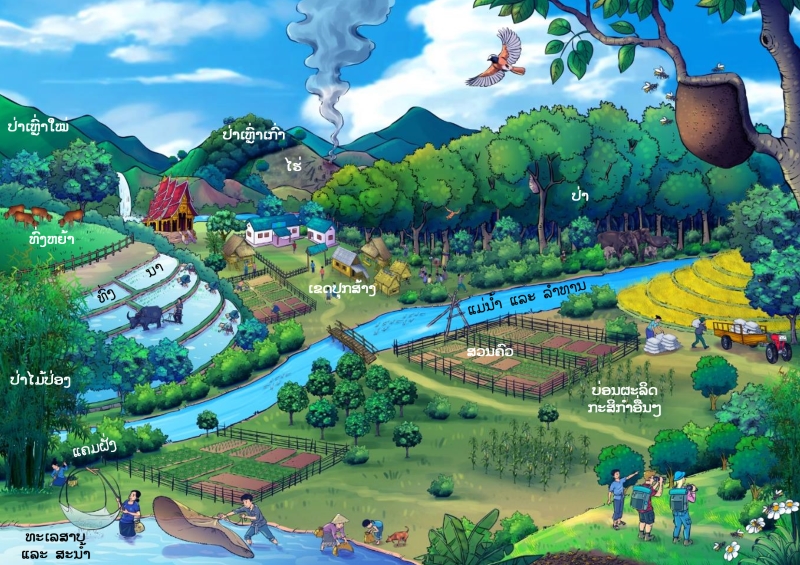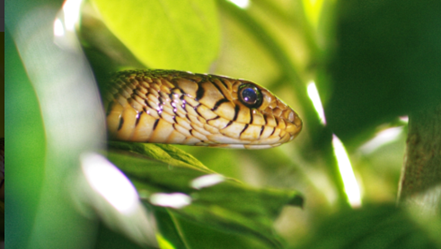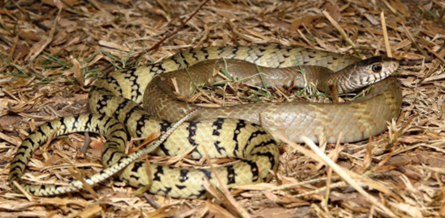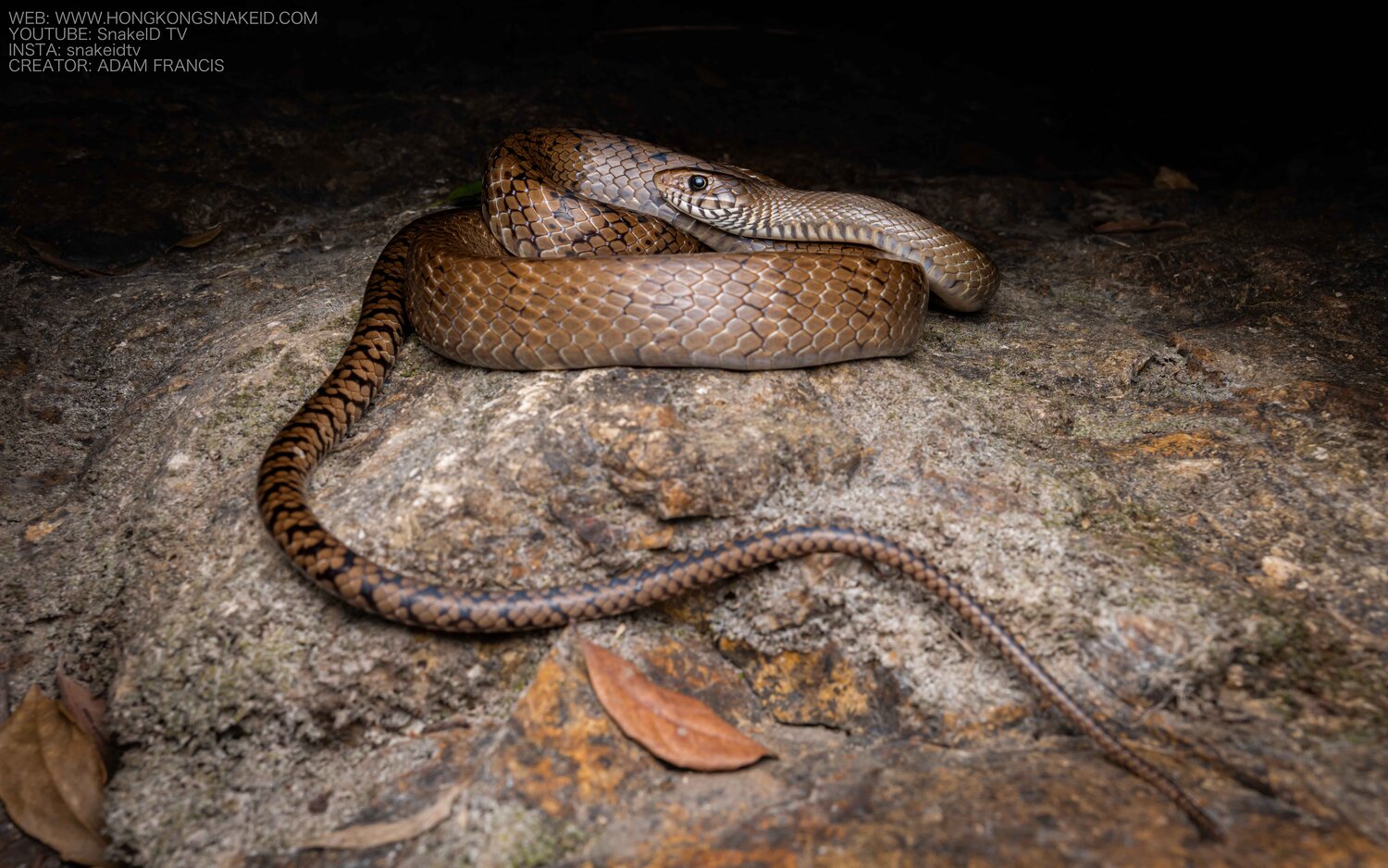ເລກລຳດັບທີ: 3850
ລະດັບການຮວບຮວມຂໍ້ມູນ: ຂໍ້ມູນພື້ນຖານ
ປັບປູງຄັ້ງລ່າສຸດ: 2024-10-19
ງູສິງ
Dhaman
Ptyas mucosa Linnaeus, 1758
ສັດ
ສັດເລືອຄານ
ສັດເລືອຄານ
×
ຊື່ທ້ອງຖີ່ນ:
ງູສິງຫາງລາຍ, ມັຣ ບລອງ (ກືມຸ) ( Common rat snake, Oriental Ratsnake)
ຊື່ພ້ອງ
:
Coluber blumenbachii Merrem, 1820
Coluber dhumna Cantor, 1839
Coluber mucosus Linnaeus, 1758
Coryphodon blumenbachii Dumeril, 1854
Leptophis trifrenatus Hallowell, 1861
Natrix mucosa Laurenti, 1768
Ptyas blumenbachii Fitzinger, 1843
Ptyas mucosus subsp. maximus Deraniyagala, 1955
Ptyas mucosus subsp. nigricans (Chernov, 1949)
Zamenis mucosus (Linnaeus, 1758)
Zaocys mucosus Wall, 1921
Coluber dhumna Cantor, 1839
Coluber mucosus Linnaeus, 1758
Coryphodon blumenbachii Dumeril, 1854
Leptophis trifrenatus Hallowell, 1861
Natrix mucosa Laurenti, 1768
Ptyas blumenbachii Fitzinger, 1843
Ptyas mucosus subsp. maximus Deraniyagala, 1955
Ptyas mucosus subsp. nigricans (Chernov, 1949)
Zamenis mucosus (Linnaeus, 1758)
Zaocys mucosus Wall, 1921
ຊື່ສະກຸນ:
Colubridae
ຊະນິດໃກ້ຄຽງ:
ບັນຍາຍລັກສະນະທາງພືດສາດ:
ເປັນງູນ້ຳທີ່ມີຂະໜາດໃຫຍ່, ຄວາມຍາວຈາກປາຍປາກຮອດຮູທະວານມີ 1,293 ມມ ແລະ ຫາງຍາວ 460 ມມ. ຫົວຍາວ ແລະ ກວ້າງກວ່າສ່ວນຂອງລຳຄໍ, ປາຍຫົວມົນ, ຕາໃຫຍ່, ລຳໂຕກົມ, ຫາງຍາວ ແລະ ປາຍຫາງຮຽວ. ຜິວໜັງລຳໂຕມີເກັດປົກຄຸມ, ເກັດເທິງຫົວເປັນແຜ່ນກວ້າງ, ເກັດສ່ວນຫຼັງຂອງລຳໂຕບໍລິເວນຕໍ່ກັບຫົວມີພື້ນຜິວລຽບ, ເກັດທ້ອງຂະຫຍາຍກວ້າງ, ເກັດໃຕ້ຫາງເປັນແຖວຄູ່, ເກັດຮອບລຳໂຕບໍລິເວນກາງລຳໂຕມີຈຳນວນ 17 ເກັດ, ເກັດທ້ອງຈຳນວນ 203 ເກັດ ແລະ ເກັດໃຕ້ຫາງຈຳນວນ 121 ເກັດ. ດ້ານເທິງຂອງຫົວ ແລະ ລຳໂຕສ່ວນຫຼັງມີສີນ້ຳຕານອົມເທົາ, ສ່ວນຫົວເຂັ້ມກວ່າລຳໂຕເລັກນ້ອຍ, ສ່ວນດ້ານໜ້າມີສີນ້ຳຕານອ່ອນ ຫຼື ສີນ້ຳຕານປົນສີເຫຼືອງ, ຄາງກະໄຕເທິງ ແລະ ຄາງກະໄຕລຸ່ມມີສິນ້ຳຕານປົນສີເຫຼືອງ ແຕ່ແຜ່ນເກັດມີຂອບສີດຳ. ລຳໂຕມີຂີດສັ້ນສີຂາວກະຈາຍຢູ່ທົ່ວລຳໂຕ ແລະ ມີຫຼາຍຢູ່ສ່ວນເທິງຫຼາຍກວ່າດ້ານລຸ່ມຂອງລຳໂຕ, ສ່ວນກາງ ແລະ ດ້ານທ້າຍຂອງລຳໂຕຈົນຮອດປາຍຫາງມີລາຍຂີດສີດຳສັ້ນຂີດຊ້ອນເປັນແຖວທາງສ່ວນລຸ່ມຂອງລຳໂຕໂດຍວາງຂວາງເປັນໄລຍະ, ຜິວໜັງລະຫວ່າງເກັດມີສິດຳ, ດ້ານທ້ອງສີຂາວ ແລະ ມີຈຸດສີນ້ຳຕານກະຈາຍຢ່າງໜາແໜ້ນຢູ່ທາງສວ່ນທ້າຍຂອງທ້ອງ, ໃຕ້ຫາງມີສີເຫຼືອງ.
ຖິ່ນອາໄສ: ອາໄສຢູ່ຕາມພື້ນປ່າຫຼາຍປະເພດ ແລະ ບາງຄັ້ງກໍພົບຢູ່ແຫຼ່ງອາໄສຂອງຄົນ
ອາຫານ: ອອກຫາກິນໃນຍາມກາງເວັນບໍລິເວນພື້ນດິນ, ອາຫານແມ່ນສາມາດກິນສັດໄດ້ຫຼາຍປະເພດ ເຊັ່ນ: ໜູ, ຈີຈ້ຽມ, ກົບ, ນົກ ແລະ ສັດຂະໜາດນ້ອຍອື່ນໆ.
ນິໄສ: ເລືອຂຶ້ນຕົ້ນໄມ້ໄດ້ບໍ່ດີປານໃດ, ແຕ່ລອຍນ້ຳໄດ້ດີ ໂດຍມີລັກສະນະທີ່ຊູສ່ວນຫົວຂຶ້ນມາເໜືອນ້ຳ, ເມື່ອຖືກລົບກວນຈະພາຍາຍາມເລືອໜີ ແຕ່ເມື່ອພາຍາຍາມໜີບໍ່ໄດ້ຈະຍົກສ່ວນຫົວ ຫຼື ສ່ວນໜ້າຂອງລຳໂຕຂຶ້ນມາສູງຈາກພື້ນດິນ, ແກ່ວງຫາງຖີ່, ສ່ວນດ້ານຂ້າງຂອງລຳຄໍຈະຂະຫຍາຍກວ້າງອອກ ແລ້ວພັບສ່ວນໜ້າຂອງລຳໂຕໄປມາ ພ້ອມທັງມີສຽງຂູ່ບໍ່ໃຫ້ເຂົ້າໃກ້, ເປັນງູທີ່ເລືອໄດ້ໄວຫຼາຍ ແລະ ມີຂໍ້ດ້ອຍໃນການໃຊ້ລຳໂຕຮັດເຍື່ອ.
ຖິ່ນອາໄສ: ອາໄສຢູ່ຕາມພື້ນປ່າຫຼາຍປະເພດ ແລະ ບາງຄັ້ງກໍພົບຢູ່ແຫຼ່ງອາໄສຂອງຄົນ
ອາຫານ: ອອກຫາກິນໃນຍາມກາງເວັນບໍລິເວນພື້ນດິນ, ອາຫານແມ່ນສາມາດກິນສັດໄດ້ຫຼາຍປະເພດ ເຊັ່ນ: ໜູ, ຈີຈ້ຽມ, ກົບ, ນົກ ແລະ ສັດຂະໜາດນ້ອຍອື່ນໆ.
ນິໄສ: ເລືອຂຶ້ນຕົ້ນໄມ້ໄດ້ບໍ່ດີປານໃດ, ແຕ່ລອຍນ້ຳໄດ້ດີ ໂດຍມີລັກສະນະທີ່ຊູສ່ວນຫົວຂຶ້ນມາເໜືອນ້ຳ, ເມື່ອຖືກລົບກວນຈະພາຍາຍາມເລືອໜີ ແຕ່ເມື່ອພາຍາຍາມໜີບໍ່ໄດ້ຈະຍົກສ່ວນຫົວ ຫຼື ສ່ວນໜ້າຂອງລຳໂຕຂຶ້ນມາສູງຈາກພື້ນດິນ, ແກ່ວງຫາງຖີ່, ສ່ວນດ້ານຂ້າງຂອງລຳຄໍຈະຂະຫຍາຍກວ້າງອອກ ແລ້ວພັບສ່ວນໜ້າຂອງລຳໂຕໄປມາ ພ້ອມທັງມີສຽງຂູ່ບໍ່ໃຫ້ເຂົ້າໃກ້, ເປັນງູທີ່ເລືອໄດ້ໄວຫຼາຍ ແລະ ມີຂໍ້ດ້ອຍໃນການໃຊ້ລຳໂຕຮັດເຍື່ອ.
ນິເວດວິທະຍາ
ເຂດກະຈາຍພັນທົ່ວໂລກ:
Native to: Afghanistan, Bangladesh, Cambodia, China, India Indonesia, Laos, Malaysia, Myanmar, Nepal, Pakistan,Sri Lanka, Taiwan, Thailand; Turkmenistan and Viet Nam.
Source: [7]
Source: [7]
ເຂດກະຈາຍພັນໃນລາວ
:
ເຂດພູສູງພາກເໜືອຂອງລາວ
ລຽບແມ່ນ້ຳຂອງພາກເໜືອ
ເຂດພູສູງສາຍພູຫຼວງ ແລະ ເຂດພູພຽງແຂວງຊຽງຂວາງ
ທົ່ງພຽງວຽງຈັນ
ເຂດສາຍພູຫຼວງຕອນລຸ່ມ
ສາຍພູຫຼວງພາກໃຕ້
ເຂດລຽບແມ່ນ້ຳຂອງພາກໃຕ້
ພູພຽງບໍລິເວນ
ລຽບແມ່ນ້ຳຂອງພາກເໜືອ
ເຂດພູສູງສາຍພູຫຼວງ ແລະ ເຂດພູພຽງແຂວງຊຽງຂວາງ
ທົ່ງພຽງວຽງຈັນ
ເຂດສາຍພູຫຼວງຕອນລຸ່ມ
ສາຍພູຫຼວງພາກໃຕ້
ເຂດລຽບແມ່ນ້ຳຂອງພາກໃຕ້
ພູພຽງບໍລິເວນ

ເຂດກະຈາຍພັນຕາມພູມສັນຖານ
:
ປ່າປະສົມປ່ຽນໃບ
ແມ່ນ້ຳ ແລະ ລຳທານ
ທົ່ງນາ
ທົ່ງຫຍ້າ
ແມ່ນ້ຳ ແລະ ລຳທານ
ທົ່ງນາ
ທົ່ງຫຍ້າ

ສະເພາະຖິ່ນໃນລາວ:
ພື້ນເມືອງ
ຮຸກຮານ
:
ບໍ່ຮຸກຮານ
ສະຖານະພາບການອະນູຮັກ IUCN
:
ມີຄວາມສ່ຽງໜ້ອຍສຸດ
ສະຖານະພາບການອະນຸຮັກແຫ່ງຊາດລາວ
:
ບັນຊີທີ່ II: ສະນິດພັນປະເພດຄຸ້ມຄອງ
ການນຳໃຊ້
ປະເພດການນຳໃຊ້:
ການຄົມມະນາຄົມ
ບໍ່ແນະນຳໃຫ້ໃຊ້
ອາຫານ
ບໍ່ແນະນຳໃຫ້ໃຊ້
ອາຫານ
ບັນຍາຍການນຳໃຊ້:
ການປູກ ການລ້ຽງ:
ຊະນິດທຳມະຊາດ
ລະດູການເກັບກູ້:
ເມສາ
ພຶກສະພາ
ມິຖຸນາ
ກໍລະກົດ
ສິງຫາ
ກັນຍາ
ຕຸລາ
ພຶກສະພາ
ມິຖຸນາ
ກໍລະກົດ
ສິງຫາ
ກັນຍາ
ຕຸລາ
ການຕະຫຼາດ ແລະ ຕ່ອງໂສ້ມູນຄ່າ:
N/A
ການຄຸ້ມຄອງຈັດການ
N/A
ໂພຊະນາການ
ຄຸນຄ່າທາງໂພຊະນາການ:
ບັນຍາຍຄຸນຄ່າທາງໂພຊະນາການ:
N/A
| ສານອາຫານ | /100g | ໝາຍເຫດ |
|---|---|---|
| ໂປຣຕີນ | N/A | N/A |
| ຄາໂບໄຮເດຣດ | N/A | N/A |
| ໄຂມັນ | N/A | N/A |
| ວິຕາມິນ | N/A | N/A |
| ແຮ່ທາດ | N/A | N/A |
| ເສັ້ນໄຍ | N/A | N/A |
ອ້າງອິງ
ເຄດິດຮູບພາບ:
Oriental rat snake up close. [1] iNaturalist [Online]. Uploaded on 17 May 2021 by Saluni. Available: https://www.inaturalist.org/observations/79119610 [Accessed: 21 August 2024]
Oriental rat snake’s whole body. [2] iNaturalist [Online]. Uploaded on 20 April 2024 by: patrick-dons. Available: https://www.inaturalist.org/photos/368845688. [Accessed: 21 August 2024
Oriental rat snake from afar. [3] iNaturalist [Online]. Uploaded on 18 April 2024 by Vamax. Available: https://www.inaturalist.org/observations/207876552 [Accessed: 21 August 2024]
Oriental rat snake’s whole body. [2] iNaturalist [Online]. Uploaded on 20 April 2024 by: patrick-dons. Available: https://www.inaturalist.org/photos/368845688. [Accessed: 21 August 2024
Oriental rat snake from afar. [3] iNaturalist [Online]. Uploaded on 18 April 2024 by Vamax. Available: https://www.inaturalist.org/observations/207876552 [Accessed: 21 August 2024]
ອ້າງອິງ:
[4] I. D. Das, “Snake of Thailand and Southeast Asia,” 3rd ed. Bangkok, Thailand: Asia books. 2021
[5] ຄຳຫລ້າ ອິນຄະວິໄລ, ທະນັນ ໂຄດປະທຸມ, ໄພວຽງ ວົງຄຳແຫງ ແລະ A. D. starr. “ຄູມືຄວາມຫລາກຫລາຍທາງຊະນິດ ສັດເຄິ່ງບົກ-ເຄິ່ງນ້ຳ ແລະ ສັດເລືອຄານ ເຂດອະນຸລັກປ່າໂຄກ ໂອງ-ໂມງ ແຫ່ງຊາດ ແຂວງ ສະຫວັນນະເຂດ ສປປ ລາວ,” ນະຄອນຫລວງ ວຽງຈັນ: ໂຄງການຄຸ້ມຄອງທີ່ດິນ ແລະ ປ່າໄມ້ແບບຍືນຍົງ ຢູໃນລະບົບນິເວດປ່າໂຄກພາກໃຕ້ ຂອງ ສປປ ລາວ. 2021
[6] Thailand National parks [online]. Available: https://www.thainationalparks.com/species/ptyas-mucosa [Accessed: 21 August.08.2024]
[7] Global Biodiversity Information Facility (GBIF), “Ptyas mucosa (Linnaeus, 1758)” [Online]. Available: https://www.gbif.org/species/5224052. [Accessed: 04 October 2024].
[8] IUCN Red List, "Dremomys rufigenis," 2024. [Online]. Available: https://www.iucnredlist.org/species/164644/1063584. [Accessed: Oct. 19, 2024].
[9] TRAFFIC Southeast Asia. [Online] “Conservation and impact of trade on the Oriental rat snake Ptyas mucosa in Java, Indonesia,” Available: https://www.traffic.org/site/assets/files/3211/oriental-rat-snake-java.pdf [Accessed: 21.08.2024]
[5] ຄຳຫລ້າ ອິນຄະວິໄລ, ທະນັນ ໂຄດປະທຸມ, ໄພວຽງ ວົງຄຳແຫງ ແລະ A. D. starr. “ຄູມືຄວາມຫລາກຫລາຍທາງຊະນິດ ສັດເຄິ່ງບົກ-ເຄິ່ງນ້ຳ ແລະ ສັດເລືອຄານ ເຂດອະນຸລັກປ່າໂຄກ ໂອງ-ໂມງ ແຫ່ງຊາດ ແຂວງ ສະຫວັນນະເຂດ ສປປ ລາວ,” ນະຄອນຫລວງ ວຽງຈັນ: ໂຄງການຄຸ້ມຄອງທີ່ດິນ ແລະ ປ່າໄມ້ແບບຍືນຍົງ ຢູໃນລະບົບນິເວດປ່າໂຄກພາກໃຕ້ ຂອງ ສປປ ລາວ. 2021
[6] Thailand National parks [online]. Available: https://www.thainationalparks.com/species/ptyas-mucosa [Accessed: 21 August.08.2024]
[7] Global Biodiversity Information Facility (GBIF), “Ptyas mucosa (Linnaeus, 1758)” [Online]. Available: https://www.gbif.org/species/5224052. [Accessed: 04 October 2024].
[8] IUCN Red List, "Dremomys rufigenis," 2024. [Online]. Available: https://www.iucnredlist.org/species/164644/1063584. [Accessed: Oct. 19, 2024].
[9] TRAFFIC Southeast Asia. [Online] “Conservation and impact of trade on the Oriental rat snake Ptyas mucosa in Java, Indonesia,” Available: https://www.traffic.org/site/assets/files/3211/oriental-rat-snake-java.pdf [Accessed: 21.08.2024]
ຜູ້ສ້າງ Factsheet:
ຜູ້ກວດສອບ Factsheet:
,


